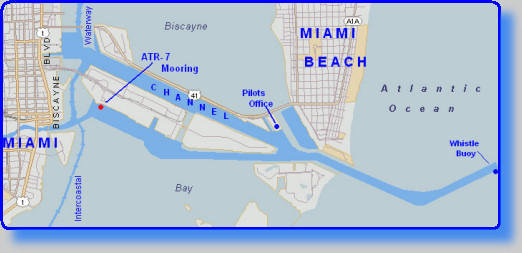|
History of ATR-7 - Page 5 At 1455 on
Monday 22 May, ATR-7 came
abeam of the Miami Whistle Buoy and sailed along the channel into Biscayne Bay, Miami which was
lined with beautiful hotels and a skyline with
palm trees everywhere. They had just passed the great breakwater built
of
large rocks. An exchange of blinker signals followed and soon she was
berthed at one the three piers, ready to begin duty at her new station.
|
|
| The Captain went ashore and the familiar absentee pennant flew on a halyard above ATR-7's bridge. SK1 also went ashore for mail and after some time returned with letters for the crew and mail, which also meant work for the ships YN2. The next day the Captain transferred half a dozen men and replaced them with new crew members. ATR-7's assignment in Miami was to train crews assigned to other new ocean tugs still under construction........................................... |
..
 Miami channel is 300- 400 ft wide and is
occasionally
restricted
to the north by shoaling. There are no major repair facilities or
drydocks for large
vessels in Miami. The nearest repair facilities are at Jacksonville and
Tampa.
|
|
The first of about 30 men came on board on Monday 29 May for a day of instruction on
salvage and rescue work. Lines were cast off and ATR-7 pulled away from
the pier, turned, and then slowly moved down the channel towards open
sea. All morning and afternoon she cruised several miles off the coast
of Miami Beach. During this time the crew demonstrated the various
salvage gear and other equipment on board. In the afternoon, she
anchored and put a diver over the side. In late afternoon she returned
to port and discharged her crew of "students". Every three days a new
group of men and officers came aboard. Sunday was the only day off. The second day of instruction was to perform refueling with one of the wooden hulled minesweepers also stationed in the port. This exercise involved two ships sailing parallel in the open ocean. A line was passed from ATR-7 to the minesweeper, followed by a heavier line, one that then supported a big 4 inch rubber fuel hose. When the hose was secured, the two ships would sail parallel for 15 or 20 minutes to simulate pumping oil from ATR-7 to the other craft. |
|
Go to Navy Stories
